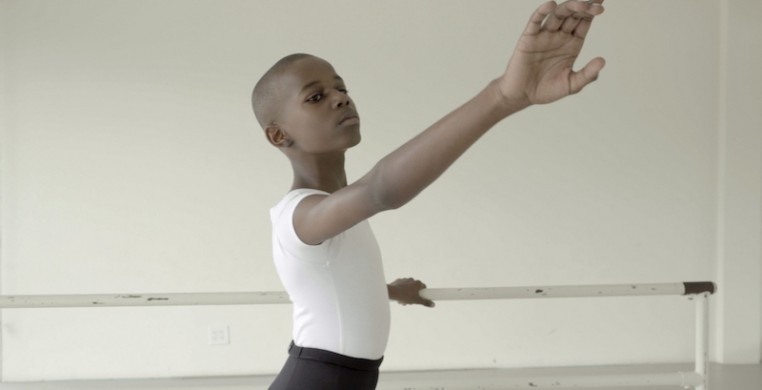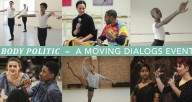As if planned, on September fourth, just as the dust began to settle on Lara Spencer’s comments on Good Morning America, community members filed into the theater at the Ruth Page Center for the Arts for a screening of "Danseur," a film by by Scott Gormley, as part of See Chicago Dance’s Moving Dialogs series. The documentary interviews a wide range of men and boys in various stages of their training and careers, and asks them about their experiences with harassment and bullying. The film was followed up by a 45-minute panel discussion moderated and curated by SCD interim executive director Surinder Martignetti, designed to represent a diverse range of voices from various marginalized groups within the Chicago dance community. Panelists included Gormley, director and producer for NuArts Productions; Kia Smith, founding artistic director and choreographer of South Chicago Dance Theatre; Victor Alexander, director of the Ruth Page School of Dance and co-director of Ruth Page Civic Ballet and myself, a freelance dancer, choreographer and dance writer.
The documentary utilized stark statistics collected by Dr. Doug Risner at Wayne State University and fleshed them out with dozens of interviews collected from a racially diverse group of male dancers ranging from young trainees like Joziah German to Boston Ballet principal dancer John Lam. According to Risner’s research presented in "Danseur," 96% of boys face verbal or physical abuse when they choose to dance and 85% of male dancers are bullied or harassed by their peers at school. This should come as no surprise, as the issue has rightfully garnered quite a bit of attention recently. In late August, Lara Spencer mocked Prince George’s love of ballet on Good Morning America. She was met with enormous push back from the dance community, culminating in over 300 dancers gathering in Times Square to take class, followed by Spencer’s public apology and a discussion with dancers Travis Wall, Fabrice Calmels and Robbie Fairchild.
Danseur finds itself in the company of a wave of dance-based social movements promoting men in dance. Boys Dance Too, an online dancewear store for men has become a hashtag and rallying cry of sorts, coupled with their Male Dancer Conference held in New York City which provides resources and a sense of community for young male dancers. While this awareness is important, the discussions surrounding men in dance, including the material presented in "Danseur," do not take into account men’s privileged position in the professional dance world or acknowledge the racial and gender minorities that dance–most specifically ballet–excludes.
In Colette Kelly’s article “Dancing Up the Glass Escalator: Institutional Advantages for Men in Ballet Choreography,” she references Christine William’s 1992 study of men in four historically female jobs: kindergarten teaching, social work, librarianship and nursing. William found that “interviews with men in each of these professions revealed a prioritization of their training, hiring and promotion over that of women to counter-balance societal pressures keeping men out of these professions, but also because men were simply seen as more capable than the women already there.” This results in a concentration of men in leadership even in jobs where the majority of the employees are women.
This effect is found in dance by looking at data collected by the Dance Data Project. Though most professional dancers are women, and according to Risner’s research only one in 10 dance students are male, that minority of men are funneled into leadership positions. According to the Dance Data Project’s “2018-2019 Season Overview” across a wide range of professional companies, 81% of works presented were choreographed by men. That same year, 19% were choreographed by women. This disparity translates to a wide gender wage gap as well, with female artistic directors making 62 cents to every dollar a man earns, according to the Dance Data Project's “Executive and Artistic Leadership Report.” Though the gap narrows to 98 cents per dollar for executive directors and general managers, in a field so clearly dominated by women the lack of female leadership is all the more stark.
By expanding the scope of gender related bias in dance, there is a notable absence of transgender visibility in the dance community. While I could not find any statistics on trans inclusion in dance, as a non-binary trans dancer myself I am connected to a wider network of transgender dancers. When I meet other trans dancers, often the first thing they say is, “Oh my gosh, there’s more than just me!” As we look to those highly funded, highly visible companies for representation, the only person I can find is Chase Johnsey, a genderfluid dancer assigned male at birth who was contracted to the run of "Sleeping Beauty" with the English National Ballet. This lack of representation is not for lack of trying. New York boasts companies like Katy Pyle’s Ballez, that “celebrates the emotionally expressive dancing of queers, dykes, fags, and trans and gender non-conforming dancers whose identities have always been a part of ballet.” Sean Dorsey is making work in San Francisco, which from all accounts has a thriving trans dance scene. Here in Chicago there is a small but mighty cohort of trans and non-binary dancers teaching, making work and dancing on professional stages across the city. During the Moving Dialogs panel, I centered my comments on this lack of representation and was received with an enthusiasm I honestly wasn’t expecting. Trans and gender non-conforming dancers have a long way to go, but it is encouraging to see that our community is on people’s radar.
Though this Moving Dialogs event was mainly focused on gender and dance, the intersectionality of race in the dance field cannot be ignored. This was briefly addressed in "Danseur" when Boston Ballet’s John Lam shares his experience as a child of Vietnamese immigrants and the racism he faces when it comes to casting. In a follow up with Dance Magazine, Lam says "I believe that if you're a white male that's tall and can partner, your career is going to be much easier than a dancer from any other ethnicity… I've dealt with things like, Oh, we don't want you in that part. They can't tell you it's because you have Asian eyes and dark hair but the presumption is that an Asian dancer has never done that role before."
Racial bias in dance is nothing new. It took seventy five years for American Ballet Theatre to promote an African American woman to principle dancer when Misty Copeland was promoted in 2015. While I was unable to find any large sample size, peer-reviewed data on race in dance, ballet’s racial diversity problem can be plainly seen by looking at America’s most visible companies. Ballet, and many other forms of dance, remain primarily white.
While race was not discussed at length during the Moving Dialogs discussion, I want to highlight panelist Kia Smith’s company South Chicago Dance Theater. The company is dancing all over Chicago and the world, presenting a fusion of “classical and contemporary dance styles” as well as preserving historical works. Her company embodies the kind of racial diversity much of the dance world currently doesn’t represent.
For parents of boys who are interested in dance, another item of note from the panel is panelist Victor Alexander’s Young Men’s Scholarship Program, providing free training to boys ages seven to 17. The discussion began with moderator Martignetti acknowledging that she has more questions than answers regarding our diverse community of dancers and the challenges we all face. Though we cannot expect to solve all our problems in one evening of discussion, I left feeling empowered by the discourse and hopeful for what dance may look like in the future.


